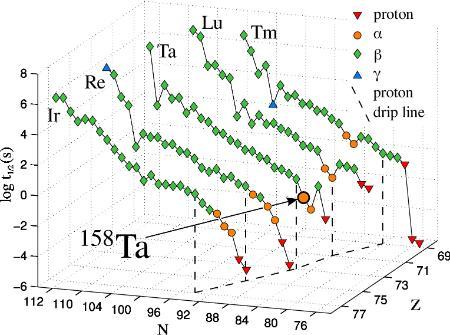D.T. Joss, R.D. Page, L.J. Harkness-Brennan
Our knowledge of the limit of the nuclear landscape is continually advancing as new nuclides are discovered every year. Ultimately, the limits of observable nuclei for most elements are dictated by the direct emission of nucleons because beyond the drip lines half-lives drop so rapidly. We are leading experiments at international accelerator laboratories probing nuclei at the proton-rich limit of the nuclear landscape, where our recent discoveries include proton emitters with sub-microsecond half-lives.

Proton emitters provide essential constraints on the validity of models describing weakly bound nuclei. In addition to being crucial for defining the limits of observable nuclei for odd-Z elements because of the sensitivity of the lifetime to the emitted proton’s energy and orbital angular momentum, proton-decay studies have delivered a wealth of information on single-particle structures beyond the proton drip line. Valuable spectroscopic information can also be obtained from measurements of α radioactivity, especially in cases where low production yields preclude the use of other probes, and γ-ray and conversion electron spectroscopy of nuclei near the proton drip. Combining all these probes provides crucial information regarding the occupation and arrangement of specific orbitals.
Occasionally measurements of nuclei beyond the proton drip line reveal major surprises such as our discovery of a multiparticle spin-trap isomer in 158Ta [1]. No proton decay branch from the isomer was identified, despite the isomer being unbound to proton emission by >3 MeV. The remarkable stability of this isomer against proton emission suggests that similar isomers in even more exotic nuclei could blur the boundaries of the nuclear landscape by providing the last observable nuclear states beyond the proton drip line. The reason for this enhanced stability in the case of 158Ta appears to come from the hindrance arising from the large spin change outweighing the effects of the higher energy release. However, this balance can work the other way to open up potential new decay modes from excited states that are not possible from lower-lying states, like the direct simultaneous emission of two protons from an isomer in 158W [2].
[1] R. J. Carroll, R.D. Page, D.T. Joss, et al., Physical Review Letters 112 (2014) 092501. doi: 10.1103/PhysRevLett.112.092501.
[2] D.T. Joss, R.D. Page, et al., Physics Letters B772 (2017) 703. doi: 10.1016/j.physletb.2017.07.031